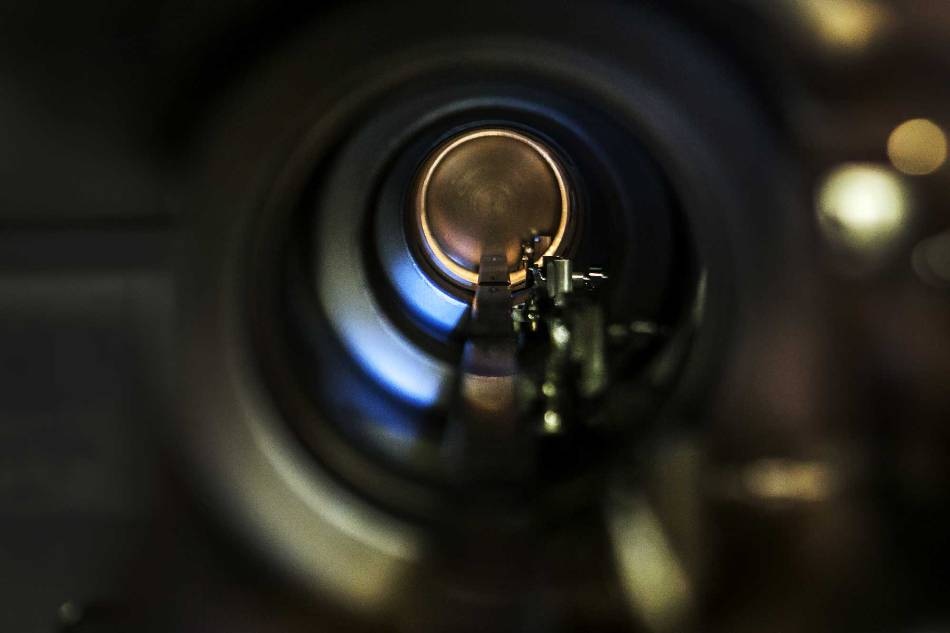Jul 20 2017
A team of Researchers from the University of Michigan have come up with a new method that peppers metallic nanoparticles into semiconductors. This progress could increase the efficiency of LED lighting by 50 % and even facilitate the creation of invisibility cloaking devices.
 The inside of the main concourse of the molecular beam epitaxy apparatus, which University of Michigan engineering researchers used to make the advanced nanoparticle-infused gallium nitride semiconductors. The semiconductors could boost LED efficiency by up to 50 percent, and even lead to invisibility cloaking devices. (Image credit: Joseph Xu, Michigan Engineering)
The inside of the main concourse of the molecular beam epitaxy apparatus, which University of Michigan engineering researchers used to make the advanced nanoparticle-infused gallium nitride semiconductors. The semiconductors could boost LED efficiency by up to 50 percent, and even lead to invisibility cloaking devices. (Image credit: Joseph Xu, Michigan Engineering)
It is the first method that can economically grow metal nanoparticles both below and on the surface of semiconductors. The process adds almost no cost during manufacturing and its enhanced efficiency could allow Manufacturers to use a lesser number of semiconductors in finished products, making them less expensive.
The metal nanoparticles can boost the efficiency of LEDs in a number of ways. They can serve as miniature antennas that modify and redirect the electricity conveyed through the semiconductor, converting more of it into light. They can also assist in reflecting light out of the device, preventing it from being captured inside and wasted.
The process can be applied with the gallium nitride that is used in LED lighting and can also increase efficiency in other semiconductor products such as solar cells. The details of the research have been published in the Journal of Applied Physics.
This is a seamless addition to the manufacturing process, and that's what makes it so exciting. The ability to make 3D structures with these nanoparticles throughout is going to open a lot of possibilities.
Rachel Goldman, U-M Professor of Materials Science and Engineering, and Physics
The key innovation
The idea of incorporating nanoparticles to boost LED efficiency is not new. But earlier efforts to add them have been unfeasible for large-scale manufacturing. They involved expensive metals like gold, silver and platinum. Furthermore, the size and spacing of the particles must be highly precise; this required extra and costly manufacturing steps. Plus, there was no cost-effective way to add particles below the surface.
Goldman's team found a simpler way that incorporates easily with the molecular beam epitaxy process used to create semiconductors. Molecular beam epitaxy sprays many layers of metallic elements onto a wafer. This forms precisely the right conductive properties for a particular purpose.
The U-M Researchers used an ion beam between these layers—a step that thrusts metal out of the semiconductor wafer and onto the surface. The metal forms nanoscale particles that act the same purpose as the expensive gold and platinum flecks in previous research. Their size and placement can be precisely manipulated by differing the intensity and angle of the ion beam. And applying the ion beam again and again between each layer forms a semiconductor with the nanoparticles scattered throughout.
If you carefully tailor the size and spacing of nanoparticles and how deeply they're embedded, you can find a sweet spot that enhances light emissions. This process gives us a much simpler and less expensive way to do that.
Myungkoo Kang, a Former Graduate Student in Goldman's lab and the study’s First Author
Researchers have been aware for years that metallic particles can gather on the surface of semiconductors during manufacturing. But they were always thought to be a nuisance, something that occurred when the mix of elements was improper or the timing was erroneous.
From the very early days of semiconductor manufacturing, the goal was always to spray a smooth layer of elements onto the surface. If the elements formed particles instead, it was considered a mistake. But we realized that those 'mistakes' are very similar to the particles that manufacturers have been trying so hard to incorporate into LEDs. So we figured out a way to make lemonade out of lemons.
Rachel Goldman, U-M Professor of Materials Science and Engineering, and Physics
Toward invisibility cloaks
Since the method allows precise control over the nanoparticle dispersal, the Researchers say it may, in the future, be beneficial for cloaks that render objects to a degree invisible by inducing a occurrence known as "reverse refraction."
Reverse refraction bends light waves backwards in a way that does not happen in nature, possibly directing them away from the eye or around an object. The Researchers are certain that carefully spacing and sizing an array of nanoparticles, they may be able to trigger and control reverse refraction in specific wavelengths of light.
"For invisibility cloaking, we need to both transmit and manipulate light in very precise ways, and that's very difficult today," Goldman said, "We believe that this process could give us the level of control we need to make it work."
The team is currently focused on adapting the ion beam process to the particular materials used in LEDs—they believe that the higher-efficiency lighting devices could be commercially ready within the next five years, with invisibility cloaking and other applications probably appearing later in the future.
The research paper is titled "Formation of embedded plasmonic Ga nanoparticle arrays and their influence on GaAs photoluminescence." The National Science Foundation through the Materials Research Science and Engineering Center at U-M supported this research.